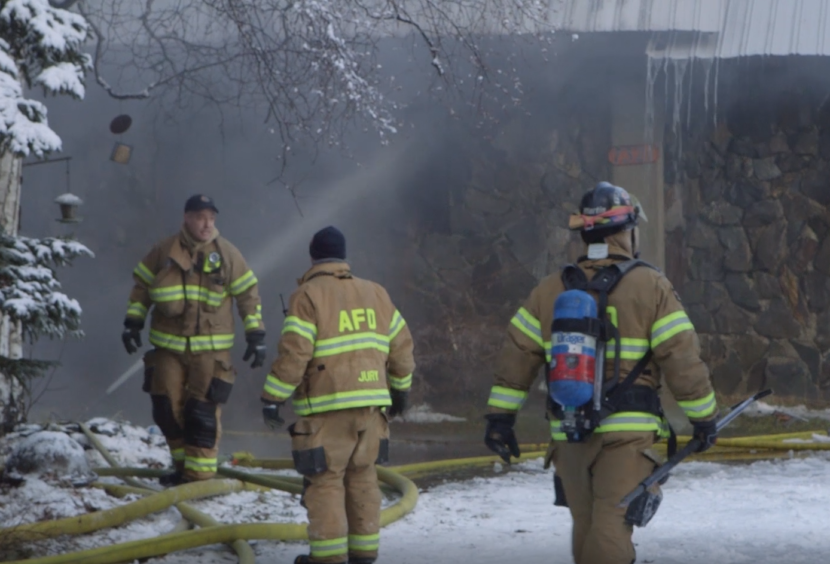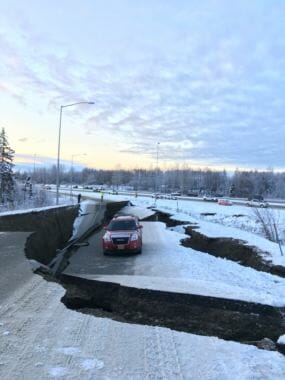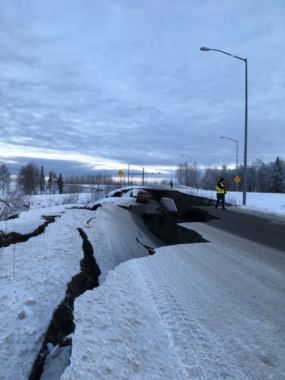
A magnitude 7.0 earthquake shook Anchorage Friday morning, damaging buildings and destroying parts of roads throughout the city.
According to the Alaska Earthquake Center, the quake hit a few miles north of Anchorage, Alaska’s most populous city. The event started at about 8:30 a.m., followed by multiple aftershocks.
The major earthquake and subsequent aftershocks left tens of thousands throughout Anchorage without power. Morning operations at Ted Stevens International Airport ground to a halt. Important roadways in and around the city suffered severe damage, causing long traffic jams and stalling repair crews. The earthquake even spurred a temporary, precautionary shutdown of the trans-Alaska pipeline.
Despite all of the destruction, as of Friday evening there were no reports of death or serious injury.
Local authorities were still assessing the damage late Friday. Anchorage Police Chief Justin Doll said earlier in the day that damage was discovered on a number of bridges and roads, including extensive deterioration of the Glenn Highway.
“Some parts of the Glenn (Highway) has sunken in and completely disappeared. We are assessing that. Significant damage that will probably take a long time to repair,” Doll said in a tweet from the Anchorage Police Department’s account.
The Glenn Highway and Seward Highway were reopened as of 12:45 p.m. Friday, according to a statement from the Anchorage Police Department. Detours still existed around damaged areas, including the South Eagle River Bridge, the Mirror Lake exit off the Glenn Highway and on Minnesota Drive.
In a Friday afternoon statement, APD advised residents to keep extinguishers on hand, check gas lines, shelter in place, keep phone lines clear and stay off the roads.
The Anchorage Water and Wastewater Utility encouraged people in Anchorage and Eagle River to boil water before drinking as a precautionary measure. The utility said it’s closed its office for the day while it responds to water line breaks and other emergencies.
Gov. Bill Walker, Anchorage Mayor Ethan Berkowitz and other Alaska officials addressed the government’s earthquake response during a press conference streamed live on Facebook Friday afternoon. Walker said he’s issued a declaration of disaster. He praised first responders, and said his administration has been in contact with the White House and the incoming administration of Gov.-elect Mike Dunleavy.
Alaskans’ safety is the state government’s highest priority, Walker said.
“It’s been a 7.2 earthquake, our response was a 10,” Walker said.
Updates from during the day:
Here’s what we know so far:
- The Alaska Department of Transportation said that a number of roads and bridges are damaged, and many traffic lights were out.
- Anchorage Police Chief Justin Doll said he is unaware of any reports of deaths or serious injuries.
- Tens of thousands have experienced power outages throughout the Anchorage area.
- The Anchorage School District announced that all Anchorage School District facilities will be closed on Monday and Tuesday, Dec. 3-4, as the district continues to assess damage.
- Ted Stevens Anchorage International Airport is open and operational as of noon Friday.
- The Alaska Railroad suspended all operations amid “severe” damage.
- The Providence Alaska Medical Center in Anchorage said it has canceled elective surgeries and that the hospital experienced multiple water leaks.
- The trans-Alaska pipeline has restarted operations after a precautionary shutdown lasted most of the day on Friday.
- The White House said President Donald Trump has been briefed about the earthquake.
- Alaska Gov. Bill Walker has issued a disaster declaration.
- The National Weather Service canceled a tsunami warning for the coastal areas of Cook Inlet and southern Kenai Peninsula.
Update (6:19 p.m.) — Alaska Public Media
The Anchorage School District announced that all Anchorage School District facilities will be closed on Monday and Tuesday, Dec. 3-4, as the district continues to assess damage. Only “essential staff” will be reporting to work.
Update (4:15 p.m.) — Ryan Cunningham, KTOO
Alyeska Pipeline has announced on Twitter that the trans-Alaska pipeline is once again operational. After inspections of the pipeline concluded there was no damage to the pipeline, workers initiated a restart around 3:30 p.m. The Alyeska Pipeline Twitter account said that surveillance of the pipeline “will remain heightened in the hours and days ahead.”
Update (2:20 p.m.) — Krysti Shallenberger, Alaska’s Energy Desk
 By midday Friday, Chugach Electric is reporting that 1,327 customers are without power. Municipal Power and Light is reporting about 1,500 customers without power. Both utilities are still figuring out the damage. (Read more.)
By midday Friday, Chugach Electric is reporting that 1,327 customers are without power. Municipal Power and Light is reporting about 1,500 customers without power. Both utilities are still figuring out the damage. (Read more.)
Update (1:20 p.m.) — Kirsten Swann, Alaska Public Media
Aftershocks continued to rock Anchorage throughout the morning Friday, according to the Alaska Earthquake Center.
The Municipality of Anchorage has issued an emergency proclamation and activated its Emergency Operation Center, according to APD and Mayor Ethan Berkowitz.
The Glenn Highway and Seward Highway were reopened as of 12:45 p.m., according to a statement from the Anchorage Police Department. Detours still exist around damaged areas including the South Eagle River Bridge, the Mirror Lake exit off the Glenn Highway and on Minnesota Drive.
In a Friday afternoon statement, APD advised residents to keep extinguishers on hand, check gas lines, shelter in place, keep phone lines open and stay off the roads. The Anchorage Water and Wastewater Utility encouraged people in Anchorage and Eagle River to boil water before drinking as a precautionary measure. The utility said it’s closed its office for the day while it responds to water line breaks and other emergencies.
Gov. Bill Walker, Lt. Gov. Valerie Davidson and Maj. Gen. Laurie Hummel are scheduled to provide an update on the earthquake’s aftermath at 2 p.m.
Update (12:30 p.m.) — Associated Press
Scientists say the damaging Alaska earthquake and aftershocks occurred on a type of fault in which one side moves down and away from the other side.
Seismologist Lucy Jones told reporters Friday at the California Institute of Technology that the fault is within the Pacific tectonic plate that is diving under Alaska, a mechanism that produces the largest earthquakes in the U.S.
Jones says the type of damage being reported is not surprising.
She says the area in which the quake occurred has loose sediments containing lots of water and when the ground moves it creates liquefaction, or “temporary quicksand.”
Jones says liquefaction can cause damage to structures because the ground moves out from beneath them.
Ted Stevens Anchorage International Airport is open and operational according to Trudy Wassel, Division Operations Manager. They are still doing an assessment of the damage; no final reports yet. She says there was a water line break but it’s not the major water line. Drinking water and sanitation are both fine. The terminals are safe to passengers.
She says they’re still checking elevators to make sure they’re working. They haven’t had a break in power.
The airport has not given instructions to the airlines to ground or delay flights. Airlines make those decisions based on each one’s protocol.
Update (11:45 a.m.) — Associated Press
Anchorage Police Chief Justin Doll says he’s been told parts of a scenic highway that heads from Anchorage toward mountains and glaciers have sunken and “completely disappeared” following the earthquake.
He says officials are evaluating the damage to the Glenn Highway but some was so significant that it will probably “take a long time to repair.”
Doll also says there has been damage reported to bridges.
Update (5:36 p.m.) — Elizabeth Jenkins, Alaska’s Energy Desk
There are multiple reports of damage on roads from the 7.0 magnitude earthquake.
The Alaska Department of Transportation in Anchorage has called in all available workers.
Shannon McCarthy, a spokesperson for DOT, calls the earthquake “scary” and is cautioning drivers to be careful.
“I myself, got to hide under a desk with a coworker this morning,” McCarthy said. “I think drivers, anything that’s flashing treat as four way stop. If the lights are completely out, treat as four-way stop. Slow and steady and everyone will be able to check on on their house and their family.”
Here’s a rundown of the sites DOT is currently working on:
- Northbound and Southbound Seward Highway are back open.
- An exit toward Palmer closed.
- The Whittier Tunnel is currently open to traffic.
- There’s a partial collapse of the ramp at the International and Minnesota Drive overpass.
- There’s a sinkhole in the road at New Seward Highway at 36 Avenue, and there’s some damage on Glenn Highway at Thunderbird Falls.
- The DOT Division of Facilities Services is conducting building assessments of state-owned buildings in the areas affected by the earthquake. Facilities staff will be working through the night and the weekend to assess damage and prepare for recovery.
DOT warns there are still many traffic lights out.
Update (11:20 a.m.) — Associated Press
Anchorage Police Chief Justin Doll says he is unaware of reports of deaths or serious injuries following the earthquake that rocked the state’s largest city.
Doll made the statement to reporters Tuesday after the quake shook buildings and damaged road infrastructure.
Update (11:05 a.m.) — Associated Press
The Alaska Railroad has suspended all operations amid “severe” damage at their Anchorage Operations Center and unknown track conditions throughout the state.
External Affairs Manager Tim Sullivan says the operations center lost power and is experiencing flooding following the quake Friday that rocked Anchorage and surrounding areas.
He says: “It’s tough to run trains when you have no dispatch.”
Sullivan says no reports of track damage have yet been reported, but it will take a day or two for staff to fully assess conditions. Until the tracks are cleared for use, all railroad operations will are suspended, Sullivan said.
The quake was felt 350 miles (560 kilometers) away in Fairbanks.
Update (10:55 a.m.) — Associated Press
The operators of the 800-mile (1,290-kilometer) long trans-Alaska pipeline said they shut the system down as a precaution following the earthquake in Southcentral Alaska.
Michelle Egan is a spokeswoman with Alyeska Pipeline Service Company.
She says there is no known damage to the pipeline.
She says data will be assessed at an operations center and a physical inspection of the line will be performed.
She says pipeline can be restarted before the physical assessment is complete.
Update (10:45 a.m.) — Associated Press
The Providence Alaska Medical Center in Anchorage says it has canceled elective surgeries and that the hospital experienced multiple water leaks.
The hospital says in a statement that there was not a large influx of patients after the quake rocked Anchorage Tuesday morning.
There were no reports of serious injuries or deaths and there were no reports of injuries at the hospital.
Update (10:40 a.m.) — Associated Press
The Federal Aviation Administration says operations have stopped at Ted Stevens Anchorage International Airport following the earthquake that rocked buildings and damaged roads.
FAA spokesman Allen Kenitzer in Washington state said Friday it’s not known when inbound flights will resume and that travelers should check with their airlines.
Kenitzer and Alaska transportation spokeswoman Meadow Bailey say telephone service is out at the airport.
The FAA spokesman says the airport tower was evacuated and flights that could be diverted were being sent to Kodiak.
He says inbound international flights to Anchorage were being guided by controllers at a regional radar approach facility.
Alaska Gov. Bill Walker tweeted that he has issued a disaster declaration.
Update (10:30 a.m.) — Associated Press
The White House says President Donald Trump has been briefed about the earthquake that rocked Anchorage, causing damage to buildings and infrastructure.
Press Secretary Sarah Huckabee Sanders tweeted Tuesday that Trump is monitoring the reports of damage.
Trump is in Argentina at the Group of 20 summit.
Huckabee adds: “We are praying for the safety of all Alaskans.”
There have been no immediate reports of serious injuries or deaths following the 7.0-magnitude earthquake.
Update (10:20 a.m.) — Associated Press
The earthquake that shook Anchorage and damaged roadways also knocked many traffic lights out of service and has snarled traffic.
Jeremy Zidek, a spokesman for the state’s Division of Homeland Security and Emergency Management, said the earthquake also disrupted some communications and electrical service.
The Anchorage School District cancelled classes for its more than 100 schools and asked parents to pick up their kids when they could.
The district wants to examine its buildings for potential damage and check for any potential gas leaks.
State government offices in Anchorage were also closed so officials could assess damage.
Update (10:02 a.m.) — Ryan Cunningham, KTOO
The National Weather Service has canceled a tsunami warning for the coastal areas of Cook Inlet and southern Kenai Peninsula. According to NWS, “No tsunami danger exists for the U.S. west coast, British Columbia and Alaska.” No destructive tsunamis have been recorded.
Update (9:43 a.m.) — Jay Barrett, KDLL-Kenai
No reports of damage in the City of Kenai this morning, though Kenai Fire Department personnel are responding to several reports of the smell of natural gas. A few years ago a similar quake caused the loss of three homes after a gas leak ignited. No word on the bridge at the Hope Cutoff yet, but the one in Kenai seems fine, though no inspection has yet taken place. No injuries or fatalities reported.
Update (9:35 a.m.) — Associated Press
Police in Alaska’s Kodiak island community have told residents to head to higher ground amid the tsunami threat from the earthquake that rocked buildings in Anchorage, caused damage to roads and sent office workers running out to the streets.
Kodiak is an island about 200 miles (321 kilometers) south of Anchorage.
The U.S. Geological Survey said it was a 7.0-magnitude quake and tsunami warnings were issued for southern Alaska coastal areas.
Update (9:25 a.m.) — Associated Press
Photographs posted to social media sites showed damage that included collapsed ceiling tiles at an Anchorage high school and buckled roadway pavement in places.
Cereal boxes and packages of batteries littered the floor of a grocery store after the earthquake Tuesday morning that rocked buildings in Alaska’s largest city, and picture frames and mirrors were knocked from living room walls.
Here’s what it looks like inside Anchorage midtown a Fred Meyer pic.twitter.com/HwF4m5j8XP
— Nat Herz (@Nat_Herz) November 30, 2018
Alaska averages 40,000 earthquakes per year, with more large quakes than the other 49 states combined.
Southern Alaska has a high risk of earthquakes due to tectonic plates sliding past each other under the region. According to the U.S. Geological Survey, the Pacific plate is sliding northwestward and plunges beneath the North American plate in southern Alaska, the Alaska Peninsula and the Aleutian Islands.
Update (9:20 a.m.)
The Anchorage School District has sent out a message requesting that parents pick up their children from school.
Reports of damage in Anchorage:
Update (9:07 a.m.):
A tsunami warning has been issued for “coastal areas of Cook Inlet and southern Kenai Peninsula.”
Estimates of the magnitude of the earthquake continue to be revised.
The Tsunami Warning Center lists the following recommendations:
If you are in a tsunami warning area;
- Evacuate inland or to higher ground above and beyond
designated tsunami hazard zones or move to an upper floor
of a multi-story building depending on your situation.- Move out of the water, off the beach, and away from
harbors, marinas, breakwaters, bays and inlets.- Be alert to and follow instructions from your local
emergency officials because they may have more detailed or
specific information for your location.- If you feel a strong earthquake or extended ground rolling
take immediate protective actions such as moving inland
and/or uphill preferably by foot.- Boat operators
- Where time and conditions permit, move your boat out to
sea to a depth of at least 180 feet.- If at sea avoid entering shallow water, harbors,
marinas, bays, and inlets to avoid floating and
submerged debris and strong currents.- Do not go to the shore to observe the tsunami.
- Do not return to the coast until local emergency officials
indicate it is safe to do so.
Original story (Associated Press)
ANCHORAGE, Alaska (AP) — A 6.6 magnitude earthquake has rocked buildings in Anchorage and caused lamp posts and trees to sway, prompting people to run out of offices and seek shelter under office desks.
The U.S. Geological Survey says the earthquake Friday morning was centered about 7 miles north of Alaska’s largest city.
An Associated Press reporter working in downtown Anchorage saw cracks in a 2-story building after the quake. It was unclear whether there were injuries.
People went back inside buildings after the earthquake but a smaller aftershock a short time later sent them running back into the streets again.


